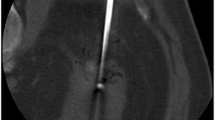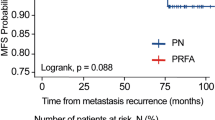Abstract
Objectives
To evaluate survival and outcomes after percutaneous radiofrequency ablation (RFA) of malignant renal tumours in high-risk patients with long-term follow-up.
Methods
Between 2002 and 2009, 62 patients (71 tumours), with a median age of 73.5 years (20–87), consecutively treated with RFA under ultrasound or computed tomography guidance for malignant renal tumours were retrospectively selected and prospectively followed until 2012, including 25 patients (40.3 %) with solitary kidney and 7 cystic cancers. Maximal tumour diameters were between 8 and 46 mm (median: 23 mm).
Results
Radiofrequency ablation was technically possible for all patients. Mean follow-up was 38.8 months (range: 18–78 months). Primary and secondary technique effectiveness was 95.2 % and 98.4 % per patient respectively. The rates of local tumour progression and metastatic evolution were 3.2 % and 9.7 % per patient and were associated with tumour size >4 cm (P = 0.005). The disease-free survival rates were 88.3 % and 61.9 % at 3 and 5 years. No significant difference in glomerular filtration rates before and after the procedure was observed (P = 0.107). The major complications rate was 5.9 % per session with an increased risk in the case of central locations (P = 0.006).
Conclusions
Percutaneous renal RFA appears to be safe and effective with useful nephron-sparing results.
Key Points
• Radiofrequency ablation (RFA) is a well-tolerated technique according to mid-term results.
• RFA for malignant renal tumours preserved renal function in high-risk patients.
• Mid-term efficacy of RFA was close to that of formal conservative surgery.
• Tumour size and central location limit the efficacy and safety of RFA.





Similar content being viewed by others
Abbreviations
- GE:
-
Gradient echo
- Gd:
-
Gadolinium
- RCC:
-
Renal cell carcinoma
- CCC:
-
Clear cell carcinoma
- CKD:
-
Chronic kidney disease
- RFA:
-
Radiofrequency ablation
References
Jayson M, Sanders H (1998) Increased incidence of serendipitously discovered renal cell carcinoma. Urology 51:203–205
Bosniak MA, Birnbaum BA, Krinsky GA, Waisman J (1995) Small renal parenchymal neoplasms: further observations on growth. Radiology 197:589–597
Homma Y, Kawabe K, Kitamura T et al (1995) Increased incidental detection and reduced mortality in renal cancer–recent retrospective analysis at eight institutions. Int J Urol 2:77–80
Bird VG, Carey RI, Ayyathurai R, Bird VY (2009) Management of renal masses with laparoscopic-guided radiofrequency ablation versus laparoscopic partial nephrectomy. J Endourol/Endourol Soc 23:81–88
Boyd O, Jackson N (2005) How is risk defined in high-risk surgical patient management? Crit Care 9:390–396
Kunkle DA, Uzzo RG (2008) Cryoablation or radiofrequency ablation of the small renal mass: a meta-analysis. Cancer 113:2671–2680
Miao Y, Ni Y, Bosmans H et al (2001) Radiofrequency ablation for eradication of renal tumor in a rabbit model by using a cooled-tip electrode technique. Ann Surg Oncol 8:651–657
Cornelis F, Balageas P, Le Bras Y, et al (2012) Radiologically-guided thermal ablation of renal tumours. Diagn Interv Imaging
Li-M S, Jarrett TW, Chan DY, Kavoussi LR, Solomon SB (2003) Percutaneous computed tomography-guided radiofrequency ablation of renal masses in high surgical risk patients: preliminary results. Urology 61:26–33
Farrell MA, Charboneau WJ, DiMarco DS et al (2003) Imaging-guided radiofrequency ablation of solid renal tumors. AJR Am J Roentgenol 180:1509–1513
Mayo-Smith WW, Dupuy DE, Parikh PM, Pezzullo JA, Cronan JJ (2003) Imaging-guided percutaneous radiofrequency ablation of solid renal masses: techniques and outcomes of 38 treatment sessions in 32 consecutive patients. AJR Am J Roentgenol 180:1503–1508
Goldberg SN, Grassi CJ, Cardella JF et al (2005) Image-guided tumor ablation: standardization of terminology and reporting criteria. J Vasc Interv Radiol 16:765–778
Bosniak MA (1997) Diagnosis and management of patients with complicated cystic lesions of the kidney. AJR 169:819–821
Tracy CR, Raman JD, Donnally C, Trimmer CK, Cadeddu JA (2010) Durable oncologic outcomes after radiofrequency ablation: experience from treating 243 small renal masses over 7.5 years. Cancer 116:3135–3142
Stern JM, Svatek R, Park S et al (2007) Intermediate comparison of partial nephrectomy and radiofrequency ablation for clinical T1a renal tumours. BJU Int 100:287–290
Gervais DA, Arellano RS, McGovern FJ, McDougal WS, Mueller PR (2005) Radiofrequency ablation of renal cell carcinoma: part 2, Lessons learned with ablation of 100 tumors. AJR Am J Roentgenol 185:72–80
Veltri A, Garetto I, Pagano E, Tosetti I, Sacchetto P, Fava C (2009) Percutaneous RF thermal ablation of renal tumors: is US guidance really less favorable than other imaging guidance techniques? Cardiovasc Interv Radiol 32:76–85
Levinson AW, Su L-M, Agarwal D et al (2008) Long-term oncological and overall outcomes of percutaneous radio frequency ablation in high risk surgical patients with a solitary small renal mass. J Urol 180:499–504
Salagierski M, Salagierski M, Salagierska-Barwinska A, Sosnowski M (2006) Percutaneous ultrasound-guided radiofrequency ablation for kidney tumors in patients with surgical risk. Int J Urol 13:1375–1379
Hiraoka K, Kawauchi A, Nakamura T, Soh J, Mikami K, Miki T (2009) Radiofrequency ablation for renal tumors: our experience. Int J Urol 16:869–873
Hui GC, Tuncali K, Tatli S, Morrison PR, Silverman SG (2008) Comparison of percutaneous and surgical approaches to renal tumor ablation: metaanalysis of effectiveness and complication rates. J Vasc Interv Radiol 19:1311–1320
Uppot RN, Silverman SG, Zagoria RJ, Tuncali K, Childs DD, Gervais DA (2009) Imaging-guided percutaneous ablation of renal cell carcinoma: a primer of how we do it. AJR Am J Roentgenol 192:1558–1570
Buy X, Tok CH, Szwarc D, Bierry G, Gangi A (2009) Thermal protection during percutaneous thermal ablation procedures: interest of carbon dioxide dissection and temperature monitoring. Cardiovasc Interv Radiol 32:529–534
Tsoumakidou G, Buy X, Garnon J, Enescu J, Gangi A (2011) Percutaneous thermal ablation: how to protect the surrounding organs. Tech Vasc Interv Radiol 14:170–176
Salas N, Ramanathan R, Dummett S, Leveillee RJ (2010) Results of radiofrequency kidney tumor ablation: renal function preservation and oncologic efficacy. World J Urol 28:583–591
Pettus JA, Werle DM, Saunders W et al (2010) Percutaneous radiofrequency ablation does not affect glomerular filtration rate. J Endourol 24:1687–1691
Cornelis F, Buy X, Andre M et al (2011) De novo renal tumors arising in kidney transplants: midterm outcome after percutaneous thermal ablation. Radiology 260:900–907
Hakime A, Hines-Peralta A, Peddi H et al (2007) Combination of radiofrequency ablation with antiangiogenic therapy for tumor ablation efficacy: study in mice. Radiology 244:464–470
Laeseke PF, Lee FT Jr, Sampson LA, van der Weide DW, Brace CL (2009) Microwave ablation versus radiofrequency ablation in the kidney: high-power triaxial antennas create larger ablation zones than similarly sized internally cooled electrodes. J Vasc Interv Radiol 20:1224–1229
Bartoletti R, Cai T, Tosoratti N et al (2010) In vivo microwave-induced porcine kidney thermoablation: results and perspectives from a pilot study of a new probe. BJU Int 106:1817–1821
Acknowledgments
The authors thank Pippa McKelvie-Sebileau for medical editorial assistance in English.
Author information
Authors and Affiliations
Corresponding author
Rights and permissions
About this article
Cite this article
Balageas, P., Cornelis, F., Le Bras, Y. et al. Ten-year experience of percutaneous image-guided radiofrequency ablation of malignant renal tumours in high-risk patients. Eur Radiol 23, 1925–1932 (2013). https://doi.org/10.1007/s00330-013-2784-3
Received:
Revised:
Accepted:
Published:
Issue Date:
DOI: https://doi.org/10.1007/s00330-013-2784-3




